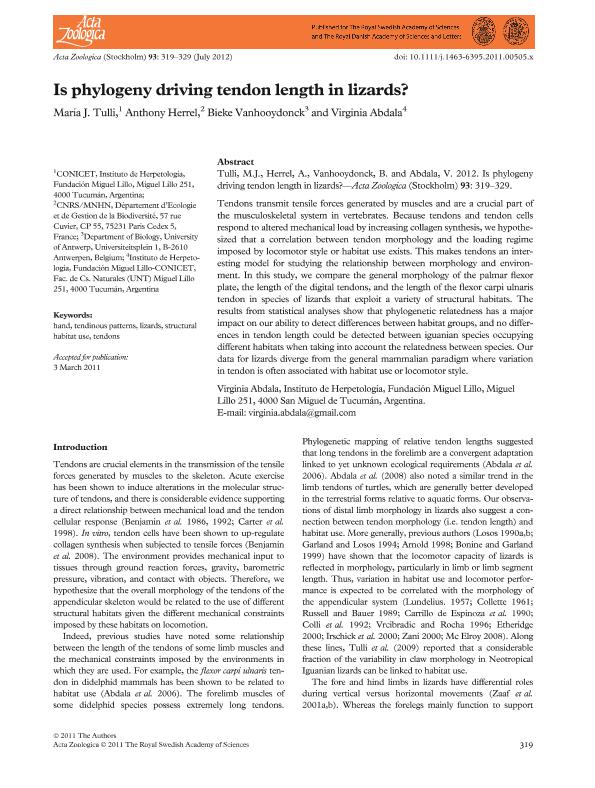Mostrar el registro sencillo del ítem
dc.contributor.author
Tulli, María José

dc.contributor.author
Herrel, Anthony

dc.contributor.author
Vanhooydonck, Bieke
dc.contributor.author
Abdala, Virginia Sara Luz

dc.date.available
2019-05-27T13:53:37Z
dc.date.issued
2012-07
dc.identifier.citation
Tulli, María José; Herrel, Anthony; Vanhooydonck, Bieke; Abdala, Virginia Sara Luz; Is phylogeny driving tendon length in lizards?; The Royal Swedish Academy of Sciences; Acta Zoologica (Stockholm); 93; 3; 7-2012; 319-329
dc.identifier.issn
1463-6395
dc.identifier.uri
http://hdl.handle.net/11336/77153
dc.description.abstract
Tendons transmit tensile forces generated by muscles and are a crucial part of the musculoskeletal system in vertebrates. Because tendons and tendon cells respond to altered mechanical load by increasing collagen synthesis, we hypothesized that a correlation between tendon morphology and the loading regime imposed by locomotor style or habitat use exists. This makes tendons an interesting model for studying the relationship between morphology and environment. In this study, we compare the general morphology of the palmar flexor plate, the length of the digital tendons, and the length of the flexor carpi ulnaris tendon in species of lizards that exploit a variety of structural habitats. The results from statistical analyses show that phylogenetic relatedness has a major impact on our ability to detect differences between habitat groups, and no differences in tendon length could be detected between iguanian species occupying different habitats when taking into account the relatedness between species. Our data for lizards diverge from the general mammalian paradigm where variation in tendon is often associated with habitat use or locomotor style.
dc.format
application/pdf
dc.language.iso
eng
dc.publisher
The Royal Swedish Academy of Sciences
dc.rights
info:eu-repo/semantics/openAccess
dc.rights.uri
https://creativecommons.org/licenses/by-nc-sa/2.5/ar/
dc.subject
Hand
dc.subject
Structural Habitat Use
dc.subject
Tendinous Patterns
dc.subject
Tendons
dc.subject.classification
Otras Ciencias Biológicas

dc.subject.classification
Ciencias Biológicas

dc.subject.classification
CIENCIAS NATURALES Y EXACTAS

dc.title
Is phylogeny driving tendon length in lizards?
dc.type
info:eu-repo/semantics/article
dc.type
info:ar-repo/semantics/artículo
dc.type
info:eu-repo/semantics/publishedVersion
dc.date.updated
2019-05-23T14:49:58Z
dc.journal.volume
93
dc.journal.number
3
dc.journal.pagination
319-329
dc.journal.pais
Suecia

dc.journal.ciudad
Estocolmo
dc.description.fil
Fil: Tulli, María José. Fundación Miguel Lillo. Dirección de Zoología. Instituto de Herpetología; Argentina. Consejo Nacional de Investigaciones Científicas y Técnicas. Centro Científico Tecnológico - Tucumán. Unidad Ejecutora Lillo; Argentina
dc.description.fil
Fil: Herrel, Anthony. Museum National D´histoire Naturelle; Francia
dc.description.fil
Fil: Vanhooydonck, Bieke. Universiteit Antwerp; Bélgica
dc.description.fil
Fil: Abdala, Virginia Sara Luz. Universidad Nacional de Tucumán; Argentina. Fundación Miguel Lillo. Dirección de Zoología. Instituto de Herpetología; Argentina. Consejo Nacional de Investigaciones Científicas y Técnicas. Centro Científico Tecnológico Conicet - Tucuman. Instituto de Biodiversidad Neotropical. Universidad Nacional de Tucuman. Facultad de Ciencias Naturales e Instituto Miguel Lillo. Instituto de Biodiversidad Neotropical. Instituto de Biodiversidad Neotropical; Argentina
dc.journal.title
Acta Zoologica (Stockholm)
dc.relation.alternativeid
info:eu-repo/semantics/altIdentifier/url/https://onlinelibrary.wiley.com/doi/abs/10.1111/j.1463-6395.2011.00505.x
dc.relation.alternativeid
info:eu-repo/semantics/altIdentifier/doi/https://dx.doi.org/10.1111/j.1463-6395.2011.00505.x/full
Archivos asociados
